Leadership and Ethics: Early Launch Project Case Study Analysis
VerifiedAdded on 2021/04/17
|6
|1392
|150
Case Study
AI Summary
This case study analysis examines the ethical dilemmas surrounding an early project launch. The scenario involves a Project Director pushing for an early launch to satisfy a client and secure future projects, despite concerns from the Team Leader and senior developers about the lack of data encryption. The analysis identifies non-ethical and ethical issues, highlighting the potential consequences of prioritizing profit over data security and client satisfaction. The case study explores the impact on various stakeholders, including the company, clients, and customers, and discusses the implications of compromised data and lack of professionalism. The analysis proposes solutions such as apologies, addressing the issues, and the importance of proper project budgeting. The study emphasizes the importance of making informed decisions, considering the impact on all stakeholders, and the importance of leadership in ensuring ethical behavior in project management.

Scenario 3: Early Launch
Paraphrase This Document
Need a fresh take? Get an instant paraphrase of this document with our AI Paraphraser
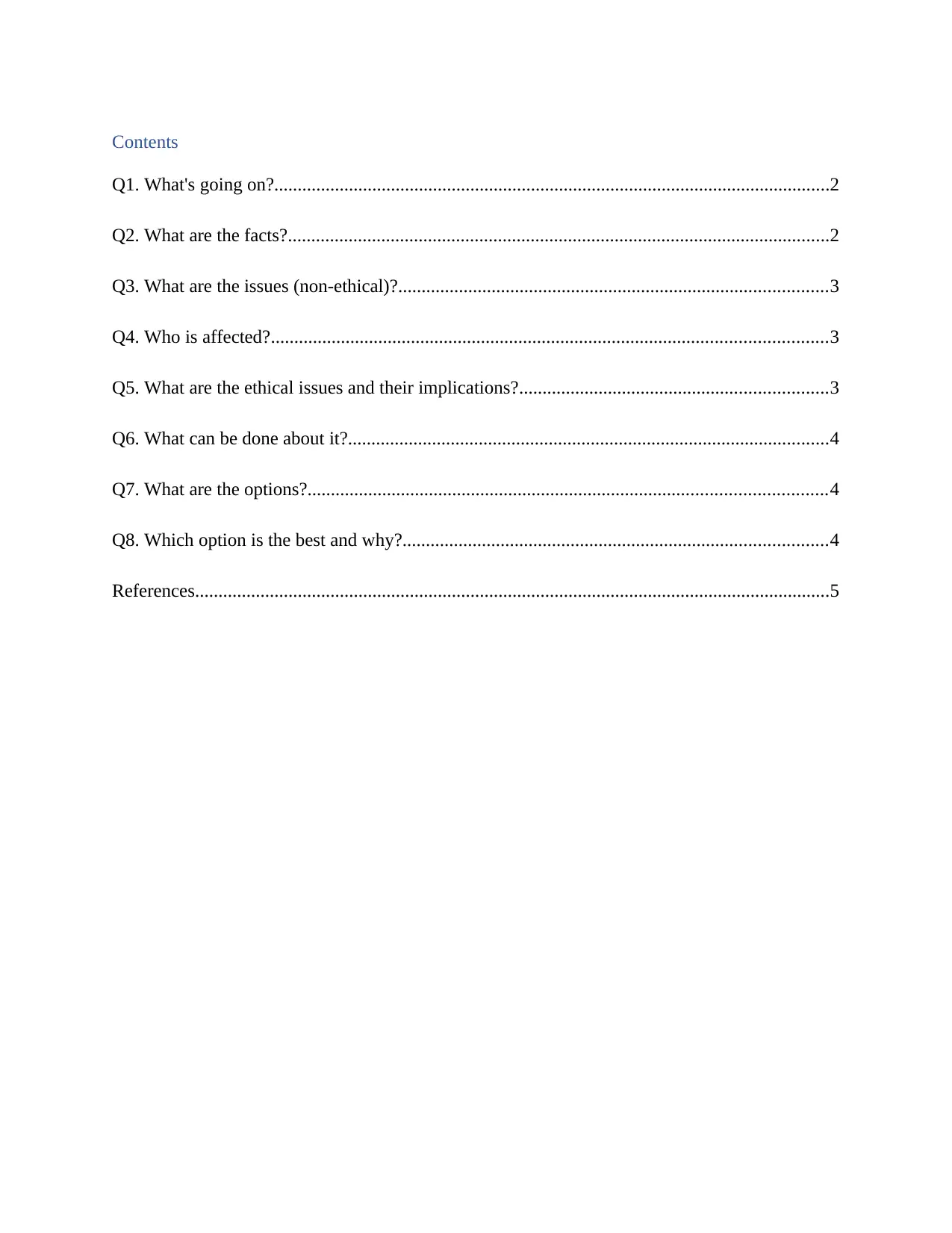
Contents
Q1. What's going on?.......................................................................................................................2
Q2. What are the facts?....................................................................................................................2
Q3. What are the issues (non-ethical)?............................................................................................3
Q4. Who is affected?.......................................................................................................................3
Q5. What are the ethical issues and their implications?..................................................................3
Q6. What can be done about it?.......................................................................................................4
Q7. What are the options?...............................................................................................................4
Q8. Which option is the best and why?...........................................................................................4
References........................................................................................................................................5
Q1. What's going on?.......................................................................................................................2
Q2. What are the facts?....................................................................................................................2
Q3. What are the issues (non-ethical)?............................................................................................3
Q4. Who is affected?.......................................................................................................................3
Q5. What are the ethical issues and their implications?..................................................................3
Q6. What can be done about it?.......................................................................................................4
Q7. What are the options?...............................................................................................................4
Q8. Which option is the best and why?...........................................................................................4
References........................................................................................................................................5
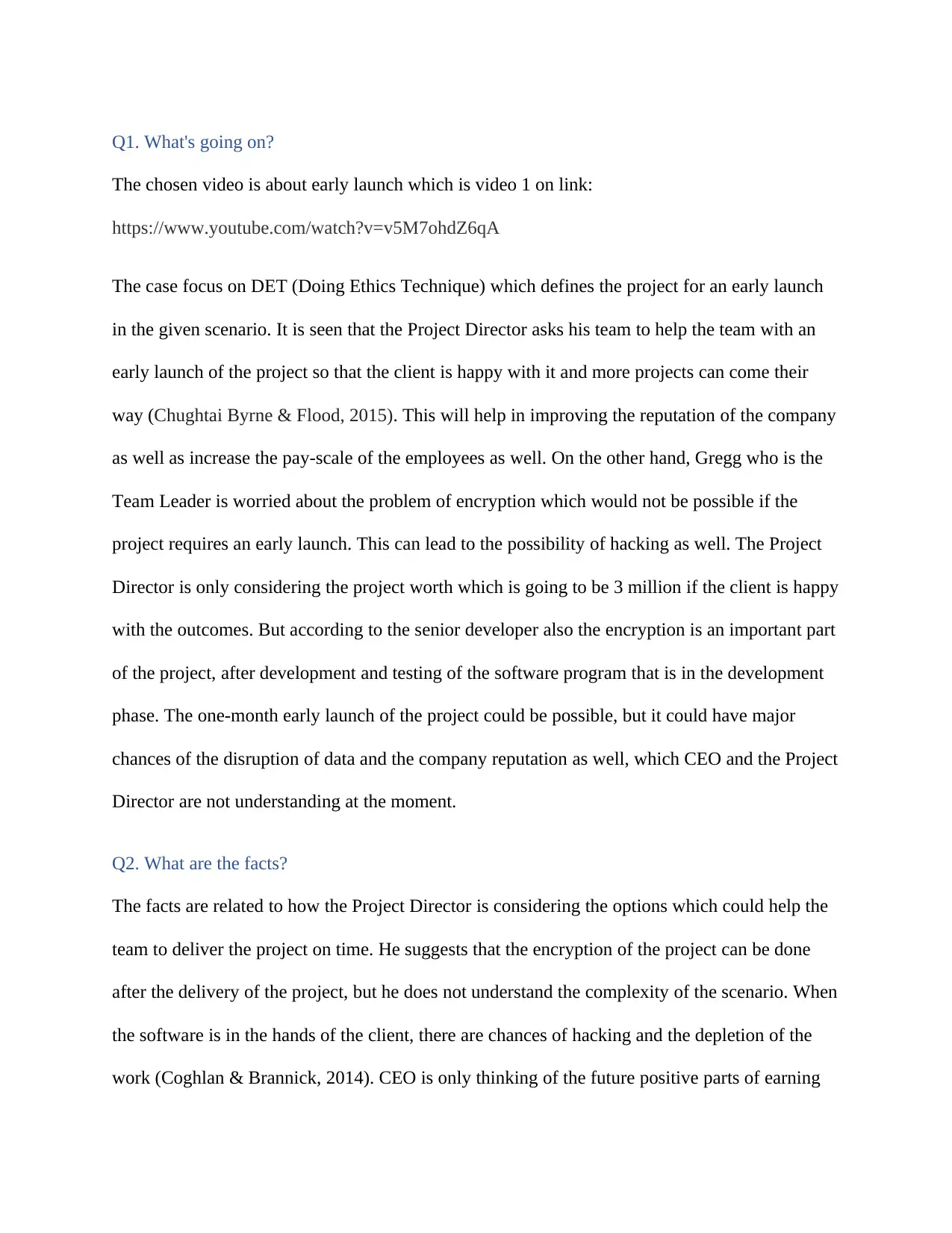
Q1. What's going on?
The chosen video is about early launch which is video 1 on link:
https://www.youtube.com/watch?v=v5M7ohdZ6qA
The case focus on DET (Doing Ethics Technique) which defines the project for an early launch
in the given scenario. It is seen that the Project Director asks his team to help the team with an
early launch of the project so that the client is happy with it and more projects can come their
way (Chughtai Byrne & Flood, 2015). This will help in improving the reputation of the company
as well as increase the pay-scale of the employees as well. On the other hand, Gregg who is the
Team Leader is worried about the problem of encryption which would not be possible if the
project requires an early launch. This can lead to the possibility of hacking as well. The Project
Director is only considering the project worth which is going to be 3 million if the client is happy
with the outcomes. But according to the senior developer also the encryption is an important part
of the project, after development and testing of the software program that is in the development
phase. The one-month early launch of the project could be possible, but it could have major
chances of the disruption of data and the company reputation as well, which CEO and the Project
Director are not understanding at the moment.
Q2. What are the facts?
The facts are related to how the Project Director is considering the options which could help the
team to deliver the project on time. He suggests that the encryption of the project can be done
after the delivery of the project, but he does not understand the complexity of the scenario. When
the software is in the hands of the client, there are chances of hacking and the depletion of the
work (Coghlan & Brannick, 2014). CEO is only thinking of the future positive parts of earning
The chosen video is about early launch which is video 1 on link:
https://www.youtube.com/watch?v=v5M7ohdZ6qA
The case focus on DET (Doing Ethics Technique) which defines the project for an early launch
in the given scenario. It is seen that the Project Director asks his team to help the team with an
early launch of the project so that the client is happy with it and more projects can come their
way (Chughtai Byrne & Flood, 2015). This will help in improving the reputation of the company
as well as increase the pay-scale of the employees as well. On the other hand, Gregg who is the
Team Leader is worried about the problem of encryption which would not be possible if the
project requires an early launch. This can lead to the possibility of hacking as well. The Project
Director is only considering the project worth which is going to be 3 million if the client is happy
with the outcomes. But according to the senior developer also the encryption is an important part
of the project, after development and testing of the software program that is in the development
phase. The one-month early launch of the project could be possible, but it could have major
chances of the disruption of data and the company reputation as well, which CEO and the Project
Director are not understanding at the moment.
Q2. What are the facts?
The facts are related to how the Project Director is considering the options which could help the
team to deliver the project on time. He suggests that the encryption of the project can be done
after the delivery of the project, but he does not understand the complexity of the scenario. When
the software is in the hands of the client, there are chances of hacking and the depletion of the
work (Coghlan & Brannick, 2014). CEO is only thinking of the future positive parts of earning
⊘ This is a preview!⊘
Do you want full access?
Subscribe today to unlock all pages.

Trusted by 1+ million students worldwide
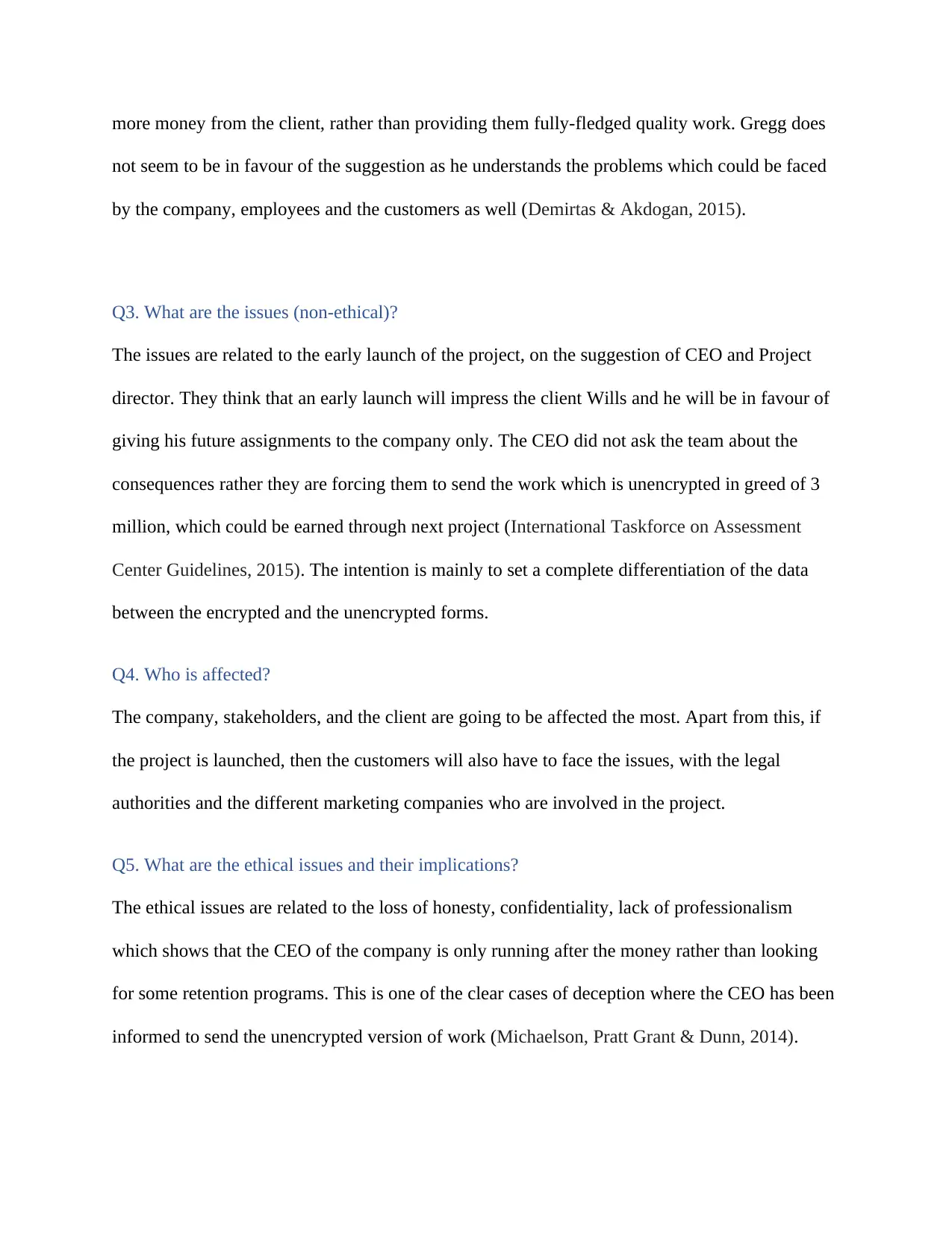
more money from the client, rather than providing them fully-fledged quality work. Gregg does
not seem to be in favour of the suggestion as he understands the problems which could be faced
by the company, employees and the customers as well (Demirtas & Akdogan, 2015).
Q3. What are the issues (non-ethical)?
The issues are related to the early launch of the project, on the suggestion of CEO and Project
director. They think that an early launch will impress the client Wills and he will be in favour of
giving his future assignments to the company only. The CEO did not ask the team about the
consequences rather they are forcing them to send the work which is unencrypted in greed of 3
million, which could be earned through next project (International Taskforce on Assessment
Center Guidelines, 2015). The intention is mainly to set a complete differentiation of the data
between the encrypted and the unencrypted forms.
Q4. Who is affected?
The company, stakeholders, and the client are going to be affected the most. Apart from this, if
the project is launched, then the customers will also have to face the issues, with the legal
authorities and the different marketing companies who are involved in the project.
Q5. What are the ethical issues and their implications?
The ethical issues are related to the loss of honesty, confidentiality, lack of professionalism
which shows that the CEO of the company is only running after the money rather than looking
for some retention programs. This is one of the clear cases of deception where the CEO has been
informed to send the unencrypted version of work (Michaelson, Pratt Grant & Dunn, 2014).
not seem to be in favour of the suggestion as he understands the problems which could be faced
by the company, employees and the customers as well (Demirtas & Akdogan, 2015).
Q3. What are the issues (non-ethical)?
The issues are related to the early launch of the project, on the suggestion of CEO and Project
director. They think that an early launch will impress the client Wills and he will be in favour of
giving his future assignments to the company only. The CEO did not ask the team about the
consequences rather they are forcing them to send the work which is unencrypted in greed of 3
million, which could be earned through next project (International Taskforce on Assessment
Center Guidelines, 2015). The intention is mainly to set a complete differentiation of the data
between the encrypted and the unencrypted forms.
Q4. Who is affected?
The company, stakeholders, and the client are going to be affected the most. Apart from this, if
the project is launched, then the customers will also have to face the issues, with the legal
authorities and the different marketing companies who are involved in the project.
Q5. What are the ethical issues and their implications?
The ethical issues are related to the loss of honesty, confidentiality, lack of professionalism
which shows that the CEO of the company is only running after the money rather than looking
for some retention programs. This is one of the clear cases of deception where the CEO has been
informed to send the unencrypted version of work (Michaelson, Pratt Grant & Dunn, 2014).
Paraphrase This Document
Need a fresh take? Get an instant paraphrase of this document with our AI Paraphraser
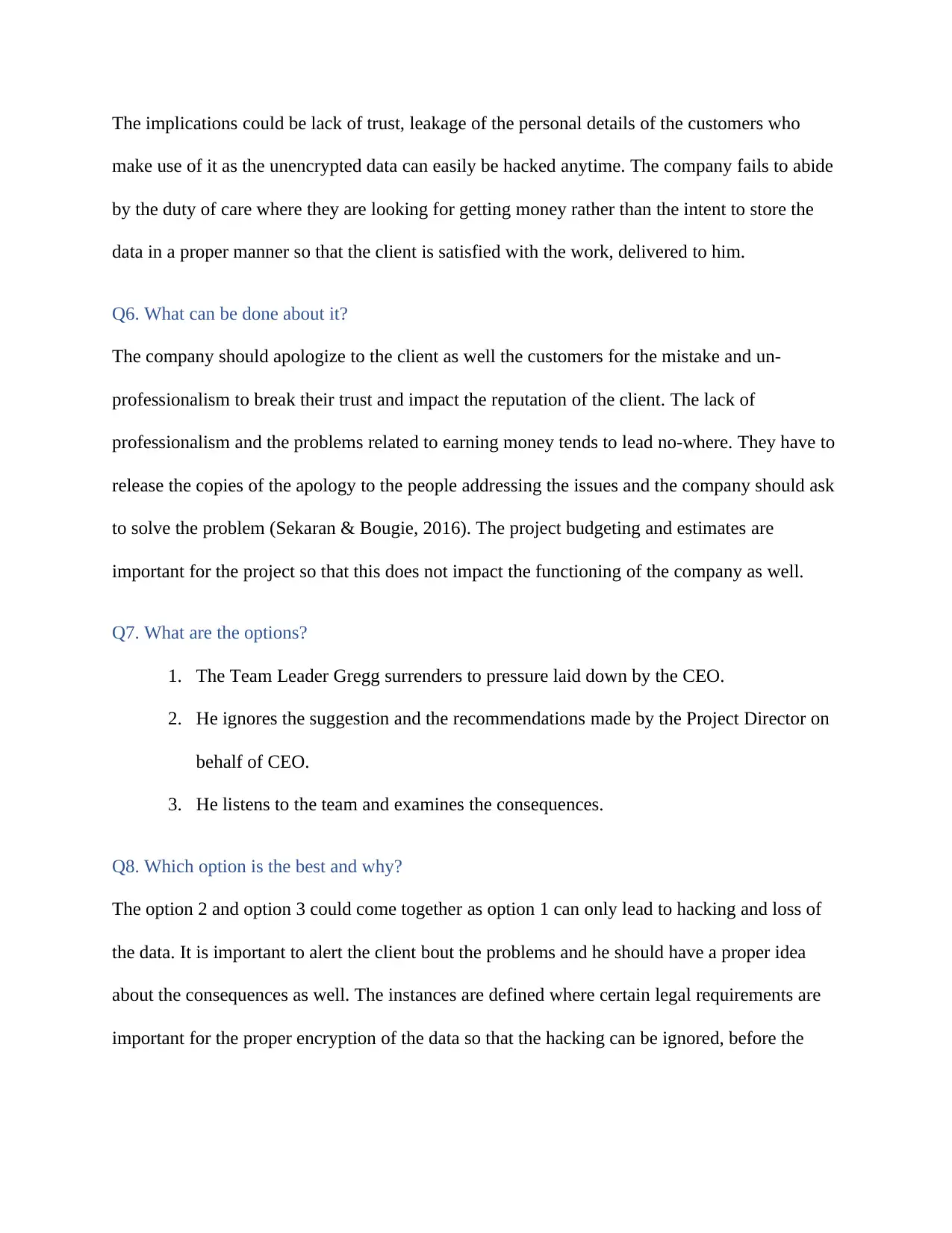
The implications could be lack of trust, leakage of the personal details of the customers who
make use of it as the unencrypted data can easily be hacked anytime. The company fails to abide
by the duty of care where they are looking for getting money rather than the intent to store the
data in a proper manner so that the client is satisfied with the work, delivered to him.
Q6. What can be done about it?
The company should apologize to the client as well the customers for the mistake and un-
professionalism to break their trust and impact the reputation of the client. The lack of
professionalism and the problems related to earning money tends to lead no-where. They have to
release the copies of the apology to the people addressing the issues and the company should ask
to solve the problem (Sekaran & Bougie, 2016). The project budgeting and estimates are
important for the project so that this does not impact the functioning of the company as well.
Q7. What are the options?
1. The Team Leader Gregg surrenders to pressure laid down by the CEO.
2. He ignores the suggestion and the recommendations made by the Project Director on
behalf of CEO.
3. He listens to the team and examines the consequences.
Q8. Which option is the best and why?
The option 2 and option 3 could come together as option 1 can only lead to hacking and loss of
the data. It is important to alert the client bout the problems and he should have a proper idea
about the consequences as well. The instances are defined where certain legal requirements are
important for the proper encryption of the data so that the hacking can be ignored, before the
make use of it as the unencrypted data can easily be hacked anytime. The company fails to abide
by the duty of care where they are looking for getting money rather than the intent to store the
data in a proper manner so that the client is satisfied with the work, delivered to him.
Q6. What can be done about it?
The company should apologize to the client as well the customers for the mistake and un-
professionalism to break their trust and impact the reputation of the client. The lack of
professionalism and the problems related to earning money tends to lead no-where. They have to
release the copies of the apology to the people addressing the issues and the company should ask
to solve the problem (Sekaran & Bougie, 2016). The project budgeting and estimates are
important for the project so that this does not impact the functioning of the company as well.
Q7. What are the options?
1. The Team Leader Gregg surrenders to pressure laid down by the CEO.
2. He ignores the suggestion and the recommendations made by the Project Director on
behalf of CEO.
3. He listens to the team and examines the consequences.
Q8. Which option is the best and why?
The option 2 and option 3 could come together as option 1 can only lead to hacking and loss of
the data. It is important to alert the client bout the problems and he should have a proper idea
about the consequences as well. The instances are defined where certain legal requirements are
important for the proper encryption of the data so that the hacking can be ignored, before the
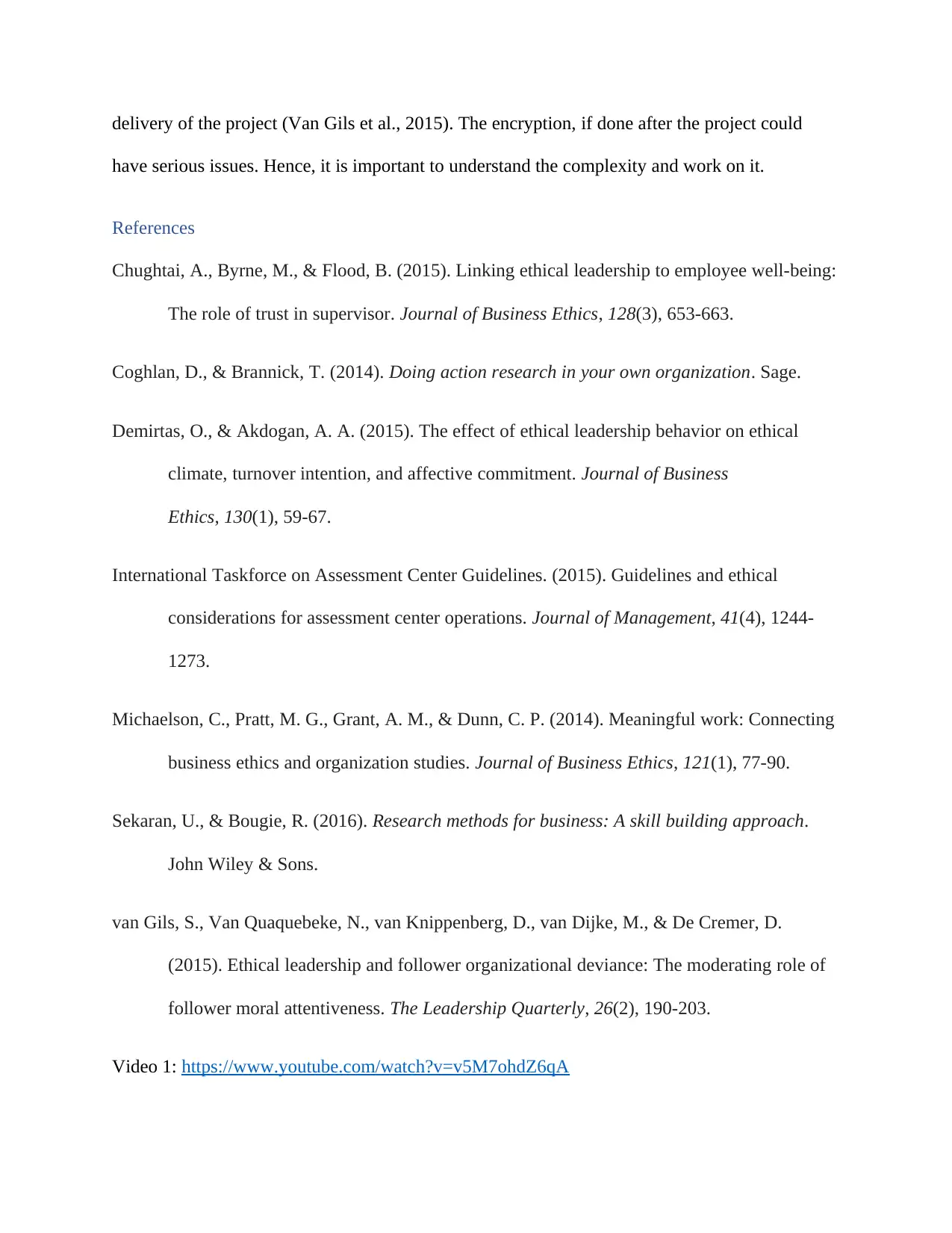
delivery of the project (Van Gils et al., 2015). The encryption, if done after the project could
have serious issues. Hence, it is important to understand the complexity and work on it.
References
Chughtai, A., Byrne, M., & Flood, B. (2015). Linking ethical leadership to employee well-being:
The role of trust in supervisor. Journal of Business Ethics, 128(3), 653-663.
Coghlan, D., & Brannick, T. (2014). Doing action research in your own organization. Sage.
Demirtas, O., & Akdogan, A. A. (2015). The effect of ethical leadership behavior on ethical
climate, turnover intention, and affective commitment. Journal of Business
Ethics, 130(1), 59-67.
International Taskforce on Assessment Center Guidelines. (2015). Guidelines and ethical
considerations for assessment center operations. Journal of Management, 41(4), 1244-
1273.
Michaelson, C., Pratt, M. G., Grant, A. M., & Dunn, C. P. (2014). Meaningful work: Connecting
business ethics and organization studies. Journal of Business Ethics, 121(1), 77-90.
Sekaran, U., & Bougie, R. (2016). Research methods for business: A skill building approach.
John Wiley & Sons.
van Gils, S., Van Quaquebeke, N., van Knippenberg, D., van Dijke, M., & De Cremer, D.
(2015). Ethical leadership and follower organizational deviance: The moderating role of
follower moral attentiveness. The Leadership Quarterly, 26(2), 190-203.
Video 1: https://www.youtube.com/watch?v=v5M7ohdZ6qA
have serious issues. Hence, it is important to understand the complexity and work on it.
References
Chughtai, A., Byrne, M., & Flood, B. (2015). Linking ethical leadership to employee well-being:
The role of trust in supervisor. Journal of Business Ethics, 128(3), 653-663.
Coghlan, D., & Brannick, T. (2014). Doing action research in your own organization. Sage.
Demirtas, O., & Akdogan, A. A. (2015). The effect of ethical leadership behavior on ethical
climate, turnover intention, and affective commitment. Journal of Business
Ethics, 130(1), 59-67.
International Taskforce on Assessment Center Guidelines. (2015). Guidelines and ethical
considerations for assessment center operations. Journal of Management, 41(4), 1244-
1273.
Michaelson, C., Pratt, M. G., Grant, A. M., & Dunn, C. P. (2014). Meaningful work: Connecting
business ethics and organization studies. Journal of Business Ethics, 121(1), 77-90.
Sekaran, U., & Bougie, R. (2016). Research methods for business: A skill building approach.
John Wiley & Sons.
van Gils, S., Van Quaquebeke, N., van Knippenberg, D., van Dijke, M., & De Cremer, D.
(2015). Ethical leadership and follower organizational deviance: The moderating role of
follower moral attentiveness. The Leadership Quarterly, 26(2), 190-203.
Video 1: https://www.youtube.com/watch?v=v5M7ohdZ6qA
⊘ This is a preview!⊘
Do you want full access?
Subscribe today to unlock all pages.

Trusted by 1+ million students worldwide
1 out of 6
Related Documents
Your All-in-One AI-Powered Toolkit for Academic Success.
+13062052269
info@desklib.com
Available 24*7 on WhatsApp / Email
![[object Object]](/_next/static/media/star-bottom.7253800d.svg)
Unlock your academic potential
Copyright © 2020–2025 A2Z Services. All Rights Reserved. Developed and managed by ZUCOL.





